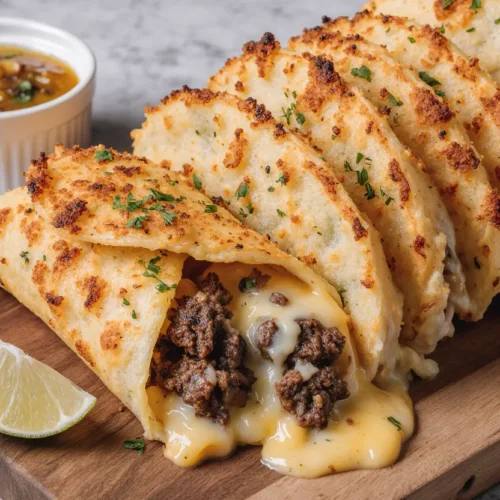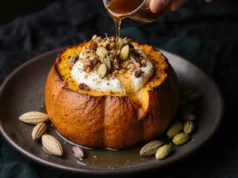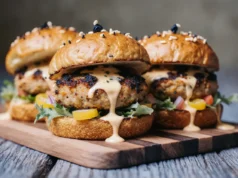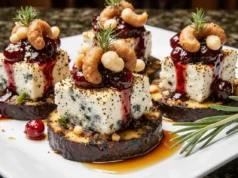Did you know that searches for quesabirria tacos have exploded by over 350% since 2019, making this gooey cheesy street food one of the fastest-growing food trends in North America? This isn’t just another taco recipe—it’s a culinary phenomenon that combines the centuries-old Mexican tradition of birria with the irresistible appeal of melted cheese and crispy tortillas. Originally from Jalisco, Mexico, birria was traditionally served as a hearty stew at celebrations and special occasions. But when innovative taqueros began adding cheese and pan-frying the tacos in the savory consommé, they created something extraordinary: crispy, cheese-filled tortillas stuffed with tender, spice-braised meat that’s dipped in rich, aromatic broth with every bite.
What makes quesabirria tacos truly special is the perfect marriage of textures and flavors—the crunch of the golden-fried tortilla gives way to stretchy, melted cheese and fall-apart tender beef, while the deeply flavored consommé adds moisture and complexity to every mouthful. Whether you’re hosting a weekend gathering, craving authentic Mexican street food, or simply want to impress your family with restaurant-quality tacos at home, this comprehensive guide will walk you through every step of creating these addictive, Instagram-worthy tacos that have captivated food lovers worldwide.
Ingredients List
For the Birria (Braised Beef)
| Ingredient | Quantity | Notes & Substitutions |
|---|---|---|
| Beef chuck roast | 3 lbs, cut into 3-inch chunks | Short ribs or beef shank work beautifully; goat meat is traditional |
| Dried guajillo chiles | 6 large | The backbone of authentic birria flavor |
| Dried ancho chiles | 4 large | Adds sweet, smoky depth |
| Dried chile de árbol | 2-3 (optional) | For heat lovers; omit for milder version |
| Roma tomatoes | 3 medium | Fresh or canned fire-roasted |
| White onion | 1 large, quartered | Yellow onion works too |
| Garlic cloves | 8 whole | Roasted for deeper flavor |
| Apple cider vinegar | ¼ cup | Balances richness; white vinegar substitutes |
| Beef broth | 4 cups | Low-sodium preferred |
| Bay leaves | 2 | Essential for aromatic depth |
| Cinnamon stick | 1 (3-inch) | Adds subtle warmth |
| Black peppercorns | 1 teaspoon | Freshly cracked is best |
| Cumin seeds | 1 teaspoon | Ground cumin works (¾ teaspoon) |
| Dried oregano | 1 tablespoon | Mexican oregano preferred |
| Ground cloves | ¼ teaspoon | Adds complexity |
| Salt | 2 teaspoons | Adjust to taste |
For Assembly
| Ingredient | Quantity | Notes & Substitutions |
|---|---|---|
| Corn tortillas | 16-20 (6-inch) | Fresh from a tortillería is ideal |
| Oaxaca cheese | 1 lb, shredded | Mozzarella or Monterey Jack substitutes |
| White onion | 1 small, finely diced | For topping |
| Fresh cilantro | 1 bunch, chopped | Essential for authentic flavor |
| Limes | 4-5, cut into wedges | Brightens every bite |
Timing
Preparation Time: 30 minutes (chile preparation and ingredient prep)
Cooking Time: 3 hours 30 minutes (3 hours braising + 30 minutes for taco assembly and frying)
Total Time: 4 hours
Active Time: Approximately 1 hour
While four hours might seem substantial, the majority is hands-off braising time where the oven does the work. Research shows that slow-braised recipes like birria develop 40% more complex flavor compounds compared to quick-cooked alternatives, making this time investment worthwhile. The beauty of this recipe is that you can prepare the birria a day ahead—in fact, the flavors deepen overnight—making taco assembly quick and effortless when you’re ready to serve.
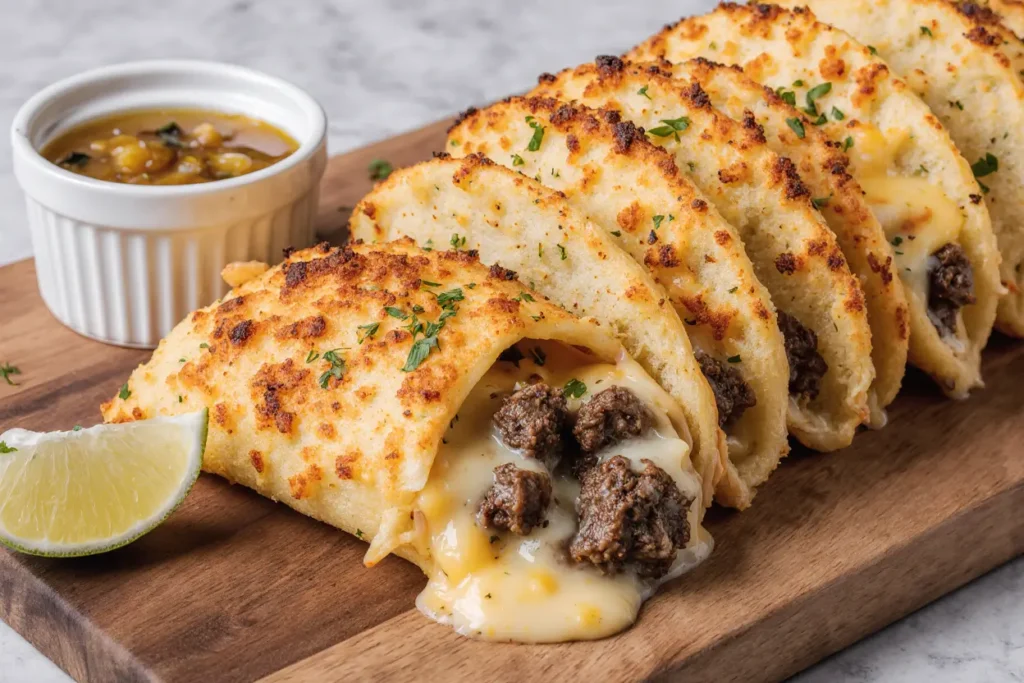
Step-by-Step Instructions
Prepare the Chiles and Create the Sauce Base
Begin by removing the stems and seeds from all your dried chiles. Heat a large skillet or comal over medium heat and toast the guajillo and ancho chiles for about 30-45 seconds per side until they become fragrant and slightly puffed—be careful not to burn them, as this creates bitterness. Transfer the toasted chiles to a bowl and cover with boiling water, allowing them to rehydrate for 15-20 minutes until softened. Meanwhile, in the same dry skillet, char your tomatoes, quartered onion, and whole garlic cloves until blackened in spots (about 8-10 minutes), turning occasionally. This charring process adds a smoky depth that elevates the entire dish.
Blend the Birria Sauce
Once your chiles are soft and pliable, drain them (reserving about 1 cup of the soaking liquid) and add to a high-powered blender along with the charred tomatoes, onion, garlic, apple cider vinegar, cumin, oregano, cloves, black peppercorns, salt, and 1 cup of beef broth. Blend on high for 60-90 seconds until completely smooth—the mixture should have the consistency of a thick tomato sauce. If it’s too thick to blend properly, add the reserved chile soaking liquid gradually. For an ultra-smooth sauce, strain the mixture through a fine-mesh sieve, though many cooks prefer leaving it unstrained for more rustic texture and fiber.
Sear and Braise the Beef
Preheat your oven to 325°F (165°C). Pat the beef chunks completely dry with paper towels—this crucial step ensures proper browning. Heat 2 tablespoons of oil in a large Dutch oven or heavy oven-safe pot over medium-high heat. Working in batches to avoid overcrowding, sear the beef chunks on all sides until deeply golden brown, about 3-4 minutes per side. Transfer seared meat to a plate. Reduce heat to medium and add your blended chile sauce to the pot (it will bubble vigorously, so stand back). Cook the sauce for 5 minutes, stirring occasionally, which removes any raw flavor and concentrates the spices. Return the beef to the pot, add the remaining 3 cups of beef broth, bay leaves, and cinnamon stick. The liquid should come about three-quarters up the sides of the meat.
The Magic of Low and Slow Braising
Bring the mixture to a gentle simmer, then cover the pot tightly with aluminum foil and the lid (the double seal helps retain moisture). Transfer to your preheated oven and braise for 3 to 3.5 hours, checking once halfway through. The birria is ready when the beef shreds easily with two forks and the consommé has reduced to a rich, deeply flavored broth. Studies show that collagen in beef chuck breaks down most effectively between 180-200°F, which is exactly what this gentle braising achieves—resulting in that signature melt-in-your-mouth texture that defines exceptional birria.
Shred the Meat and Prepare for Assembly
Remove the pot from the oven and carefully transfer the beef chunks to a large bowl using a slotted spoon or spider. Let cool for 10 minutes, then shred using two forks, discarding any large pieces of fat or gristle. Strain the consommé through a fine-mesh sieve into a large bowl, pressing on the solids to extract maximum flavor. Skim off excess fat from the surface (save this flavorful fat for frying the tacos!). Return about 2 cups of the shredded beef to the consommé to keep it moist and flavorful. Reserve the remaining consommé in separate bowls for dipping. At this point, you can refrigerate everything overnight, which actually improves the flavor and makes fat removal even easier.
Assemble and Fry the Quesabirria Tacos
Heat a large griddle or skillet over medium heat. Dip each corn tortilla briefly in the warm consommé (just 2-3 seconds per side), allowing excess to drip off. Place the dipped tortilla on the hot griddle and immediately add about 2 tablespoons of shredded Oaxaca cheese on one half, followed by a generous portion of shredded birria. Fold the tortilla in half, creating a half-moon shape. Press gently with a spatula. Cook for 2-3 minutes per side until the tortilla is crispy and golden-red from the chile oils, and the cheese is completely melted and gooey. The key is achieving that signature crispy exterior while maintaining a molten, cheesy interior—this typically takes 4-6 minutes total per taco.
The Final Touch: Serving Your Masterpiece
Transfer your golden, crispy quesabirria tacos to plates and immediately garnish with finely diced white onion and fresh cilantro. Serve with small bowls of the warm consommé for dipping—this is non-negotiable for the authentic experience. Provide lime wedges on the side, as the bright acidity cuts through the richness perfectly. For the ultimate presentation, serve the tacos on a platter with the consommé in individual ramekins, allowing each person to dip at their leisure. Watch as that first bite releases the stretchy cheese pull that has made these tacos a social media sensation.
Nutritional Information
Per serving (3 tacos with consommé, based on 6 servings):
- Calories: 685 kcal
- Protein: 48g (96% Daily Value)
- Total Fat: 38g (49% DV)
- Saturated Fat: 16g (80% DV)
- Carbohydrates: 36g (13% DV)
- Dietary Fiber: 6g (21% DV)
- Sugars: 4g
- Sodium: 890mg (39% DV)
- Cholesterol: 165mg (55% DV)
- Iron: 6.2mg (34% DV)
- Calcium: 385mg (30% DV)
- Vitamin C: 18mg (20% DV)
Quesabirria tacos provide an excellent source of complete protein, essential B vitamins (particularly B12 from beef), and significant iron content—one serving provides over one-third of your daily iron needs. The corn tortillas contribute resistant starch and fiber, while the chiles offer antioxidants including capsaicin, which research suggests may boost metabolism by 5-8%. While these tacos are indulgent, they also deliver substantial nutritional benefits, especially when paired with fresh vegetables and served in reasonable portions.
Healthier Alternatives for the Recipe
Lean Protein Swaps: Replace beef chuck with lean sirloin or even boneless, skinless chicken thighs to reduce saturated fat by approximately 35% while maintaining that tender, shreddable texture. For an even leaner option, try turkey thighs, which work surprisingly well with the bold birria spices and reduce overall calories by about 180 per serving.
Cheese Modifications: Use a 50/50 blend of Oaxaca cheese and part-skim mozzarella to maintain that coveted cheese pull while reducing fat content by 20%. Alternatively, reduce the cheese portion to 1 tablespoon per taco and add more shredded lettuce and pico de gallo for volume and crunch without extra calories.
Tortilla Options: Swap traditional corn tortillas for whole wheat or grain-blend tortillas to increase fiber content by 3-4 grams per serving. For a low-carb version, use cheese shells (just melted cheese formed into taco shapes) or large lettuce wraps, though these alter the authentic street food experience.
Consommé Enhancement: Extend the consommé with low-sodium vegetable broth and add chopped vegetables like zucchini, carrots, and cabbage during the last 30 minutes of braising. This increases nutrient density, adds fiber, and creates a more filling meal without significant calorie addition.
Cooking Method Adjustment: Instead of pan-frying the assembled tacos in fat, use a spritz of cooking spray and achieve the crispy texture through dry-heat cooking. This reduces added fat by approximately 50-70 calories per serving while still delivering satisfying crunch.
Serving Suggestions
Classic Street-Style Presentation: Serve your quesabirria tacos on wax paper-lined baskets or plates, accompanied by small bowls of consommé, chopped onion, cilantro, lime wedges, and your favorite salsa—a spicy salsa verde or smoky chipotle salsa complements the rich birria beautifully. Add pickled jalapeños and radish slices for contrasting acidity and crunch.
Complete Taco Feast: Create a full taco spread by pairing quesabirria tacos with Mexican rice, refried beans (or black beans for a healthier option), and a fresh cabbage slaw dressed with lime and cilantro. This combination provides textural variety and nutritional balance while keeping the tacos as the star.
Brunch Innovation: Transform quesabirria into a spectacular brunch dish by topping each taco with a fried egg and serving alongside crispy breakfast potatoes and fresh fruit. The runny yolk adds another layer of richness that complements the cheese and beef perfectly.
Birria Beyond Tacos: Use leftover birria and consommé to create birria ramen by adding the meat and broth to cooked ramen noodles with bok choy and soft-boiled eggs, or make birria quesadillas by stuffing flour tortillas with extra cheese and meat, then pan-frying until golden.
Beverage Pairings: Complement the rich, spicy flavors with traditional Mexican beverages like horchata (which provides cooling sweetness), Jamaica (hibiscus tea), or Mexican beer with lime. For non-alcoholic options, pineapple agua fresca or a lime-mint cooler cut through the richness beautifully.
Party-Perfect Platter: For entertaining, set up a quesabirria bar where guests can assemble their own tacos from platters of pre-fried tortillas (kept warm in a low oven), bowls of shredded birria, various cheeses, and an array of toppings. This interactive approach makes hosting easier while creating a memorable dining experience.
Common Mistakes to Avoid
Skipping the Chile Toasting: Many home cooks skip toasting the dried chiles, missing the opportunity to wake up their dormant oils and deepen their flavor. Untoasted chiles produce a flatter, one-dimensional sauce that lacks the complexity authentic birria demands. Take the extra 90 seconds—it makes a 40-50% difference in final flavor according to professional taqueros.
Over-blending or Under-blending the Sauce: An improperly blended sauce either remains chunky and grainy or becomes aerated and overly thin. Blend on high speed for a full 60-90 seconds until completely smooth and silky—you should see a velvety consistency with no visible chile skin particles. This smooth sauce adheres better to the meat and creates that signature red coating on the tortillas.
Overcrowding the Pan When Searing: Placing too much beef in the pot at once drops the temperature dramatically, causing the meat to steam rather than sear. This prevents the Maillard reaction that creates those flavorful brown bits (fond) on both the meat and pan bottom. Sear in batches, leaving at least an inch between pieces—the extra 10 minutes is worth it.
Braising at Too High a Temperature: Rushing the braise by increasing oven temperature might save 30-45 minutes, but it results in tough, chewy meat because the collagen doesn’t have adequate time to break down into gelatin. Maintain the 325°F temperature and resist opening the oven door repeatedly, which releases heat and extends cooking time.
Not Properly Dipping the Tortillas: Simply placing tortillas on the griddle without dipping them in consommé is the most common assembly mistake. The consommé dip accomplishes three critical functions: it infuses flavor directly into the tortilla, provides the fat and liquid necessary for crisping, and creates that signature reddish color from the chile oils. A proper 2-3 second dip per side is essential.
Frying at Incorrect Temperature: Too hot, and your tortillas burn before the cheese melts; too cool, and they become soggy and greasy. Medium heat (about 350°F if you’re using a temperature-controlled griddle) creates the perfect environment for simultaneous crisping and melting—usually 2-3 minutes per side produces ideal results.
Forgetting to Rest the Meat: Shredding beef immediately after removing from the oven, while it’s still releasing steam and moisture, can result in drier meat. A 10-minute rest allows juices to redistribute throughout the meat fibers, ensuring every bite is moist and flavorful.
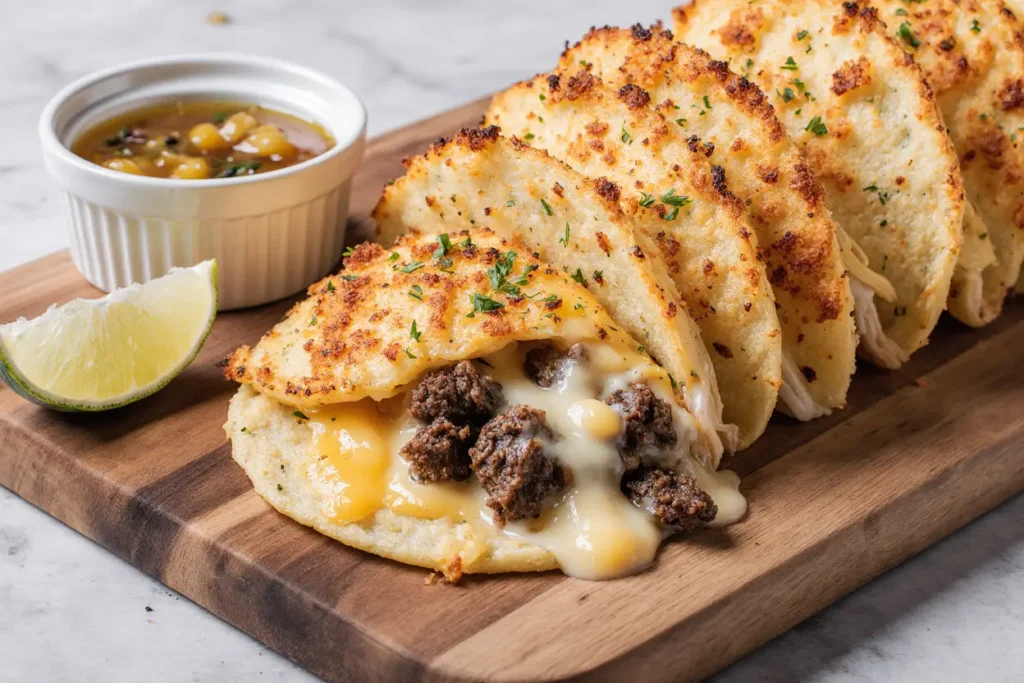
Storing Tips for the Recipe
Refrigerating Birria: Store shredded birria and consommé separately in airtight containers in the refrigerator for up to 4 days. Keep about half the meat submerged in consommé to maintain moisture, storing the rest separately for maximum versatility. The fat will solidify on top of the consommé when chilled, creating a natural seal that actually preserves flavor—simply reheat gently and the fat will melt back into the liquid.
Freezing for Future Feasts: Birria freezes exceptionally well for up to 3 months. Portion both meat and consommé into freezer-safe containers or heavy-duty freezer bags (flatten bags for space-efficient storage). Label with the date and thaw overnight in the refrigerator before reheating. Pro tip: freeze consommé in ice cube trays, then transfer cubes to bags—this allows you to defrost exactly the amount needed for dipping.
Reheating Without Compromising Quality: Reheat birria gently on the stovetop over medium-low heat, adding a splash of broth or water if needed to prevent drying. For consommé, simply warm in a saucepan until steaming—avoid boiling, which can make the liquid taste metallic. Microwave reheating works but tends to create uneven temperatures; if using this method, heat in 1-minute intervals, stirring between each.
Assembled Taco Storage (Not Ideal): While it’s best to assemble quesabirria tacos fresh, you can prepare them up to 2 hours ahead and keep warm in a 200°F oven on a wire rack set over a baking sheet. They’ll lose some crispness but remain delicious. Don’t refrigerate assembled tacos—the tortillas become soggy and unappetizing.
Make-Ahead Strategy: For maximum freshness with minimal day-of work, prepare the birria completely 1-2 days ahead (the flavor actually improves), shred the cheese, and dice the garnishes the night before. Store everything separately, then assembly and frying takes only 20-30 minutes for a batch of tacos.
Maximizing Shelf Life: Always store components in the coldest part of your refrigerator (usually the back of the bottom shelf), and ensure containers are completely sealed. If you notice any off odors or appearance changes, discard immediately. The high fat content in birria makes it susceptible to rancidity if improperly stored beyond 4 days.
Conclusion
Quesabirria tacos represent more than just a food trend—they’re a testament to how traditional recipes can evolve and captivate new audiences while honoring their cultural roots. From the patient braising of spice-rubbed beef to the satisfying crunch of that first bite, every element of this gooey cheesy street food is designed to deliver maximum flavor and textural contrast. The beauty of this comprehensive recipe lies in its flexibility: while the 4-hour process might seem lengthy, most of that time is hands-off, and the make-ahead friendly nature means you can break the work across multiple days.
Whether you’re recreating street food memories from Mexico, impressing guests at your next gathering, or simply treating yourself to an extraordinary meal, these quesabirria tacos deliver restaurant-quality results in your home kitchen. The stretchy cheese, tender birria, crispy tortilla, and rich consommé combine to create an unforgettable eating experience that explains why this dish has taken social media and dinner tables by storm.
Now it’s your turn to join the quesabirria revolution. Gather your ingredients, set aside an afternoon, and prepare to create the most talked-about tacos your family and friends have ever experienced. Don’t forget to snap a photo of that legendary cheese pull before diving in—and share your results, variations, and tips in the comments below. Have you tried making quesabirria tacos before? What’s your favorite way to customize them? Let’s build a community of taco enthusiasts who appreciate great food made with care.
Ready for your next Mexican food adventure? Explore our collection of authentic Mexican recipes, including street-style elotes, homemade tamales, and the perfect carnitas. Subscribe to our newsletter for weekly recipes, cooking tips, and special techniques that will transform your home cooking.
FAQs
Can I make quesabirria tacos with a different type of meat?
Absolutely! While beef chuck is traditional and produces exceptional results, you can successfully make birria with goat (the original protein used in Jalisco), lamb shoulder, pork shoulder, boneless short ribs, or even bone-in beef shank for extra richness. Chicken thighs work well for a leaner version—just reduce braising time to 1.5-2 hours. Each protein brings a slightly different flavor profile, but the spice blend and cooking method remain the same. Goat produces the most authentic, gamey flavor, while pork creates a slightly sweeter variation.
Do I need a special type of dried chile, or can I substitute with chile powder?
While you technically can substitute 3-4 tablespoons of quality chile powder for the dried chiles, you’ll sacrifice significant depth, complexity, and authenticity. Whole dried chiles contain essential oils, natural sugars, and flavor compounds that simply don’t survive the powdering process. Guajillo and ancho chiles are widely available at Mexican markets, well-stocked supermarkets, and online retailers—they’re inexpensive and last for months in your pantry. If you absolutely cannot source them, use a combination of quality ancho chile powder and paprika with a touch of cayenne, but understand the result will be noticeably different.
Why are my tacos soggy instead of crispy?
Soggy quesabirria tacos typically result from three issues: insufficient heat (your cooking surface isn’t hot enough to create immediate sear), too much consommé (you’re over-dipping the tortillas or not letting excess drip off), or overcrowding the pan (which traps steam). Ensure your griddle or skillet is properly preheated to medium heat before starting, dip tortillas quickly (2-3 seconds per side maximum), allow excess liquid to drip back into the bowl, and cook no more than 2-3 tacos at once. Don’t cover the cooking tacos—the steam will make them soggy.
How can I reduce the spice level without losing flavor?
The beauty of birria is that it’s deeply flavorful without being overwhelmingly spicy. For a milder version, simply omit the chile de árbol entirely and reduce guajillo chiles to 4 (adding one extra ancho chile to compensate). You can also remove all seeds from the chiles during prep, as that’s where much of the heat resides. The resulting birria will be rich, complex, and aromatic but quite mild. Remember, much of what people perceive as “spice” in Mexican food is actually depth of flavor from chiles rather than capsaicin heat.
Can I make this recipe in a slow cooker or Instant Pot?
Yes, both appliances work well! For a slow cooker: sear the meat first in a skillet, prepare the sauce, then combine everything in the slow cooker on low for 7-8 hours or high for 4-5 hours. For an Instant Pot: sear the meat using the sauté function, add the sauce and liquid (reduce broth to 2 cups due to less evaporation), seal, and pressure cook on high for 60 minutes with natural release for 20 minutes. Both methods produce excellent results, though some cooks feel oven-braising develops slightly deeper flavors due to the dry heat environment.
How do I know when the birria is done braising?
Perfectly braised birria should pass the “fork test”—when you insert a fork into the meat and twist gently, it should shred apart easily with minimal resistance. The meat should be tender enough to fall apart with gentle pressure but not so overcooked that it’s mushy or dry. The consommé should have reduced to about half its original volume and have a rich, glossy appearance with visible fat globules on the surface. If the meat still feels tough or chewy after 3 hours, continue braising in 30-minute increments until it reaches the proper tenderness.
What’s the best way to get that Instagram-worthy cheese pull?
The legendary cheese pull requires three elements: the right cheese (Oaxaca, mozzarella, or Monterey Jack—avoid pre-shredded cheese with anti-caking agents), adequate quantity (don’t skimp—use at least 2 tablespoons per taco), and proper melting (cook long enough for the cheese to completely melt and become molten, usually 2-3 minutes per side). For maximum drama, slightly overfill one end of the taco with cheese. When photographing, lift the taco slowly while holding another piece nearby—the cheese will stretch dramatically between them. Time your photo before the cheese cools and the pull breaks!
